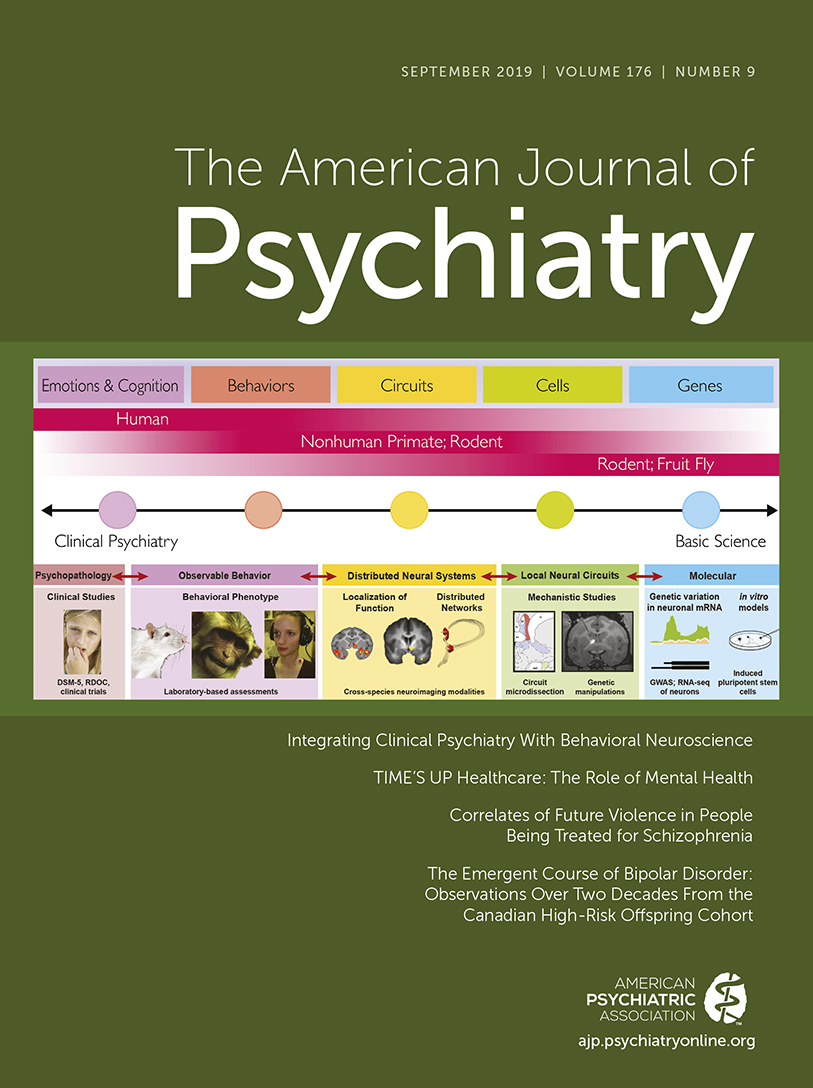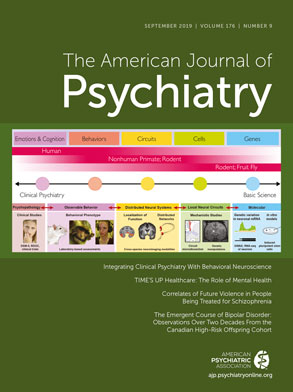The relationship between substance use disorders and schizophrenia has long intrigued mental health researchers and clinicians. The prevalence of substance use disorders in persons with schizophrenia is significantly higher than in the general population, and several substances can cause psychosis during intoxication or withdrawal. How does one differentiate schizophrenia from substance-induced psychotic disorder? When individuals develop psychosis in the context of substance use, what does that tell us in terms of etiopathophysiology and likely prognosis and outcome? In DSM-5, the distinction between substance-induced psychosis and schizophrenia is based on the persistence of psychosis beyond 1 month after last exposure to the implicated substance (
1); the 1-month criterion is somewhat arbitrary but was based on a comprehensive review of relevant data.
Although there have been several efforts directed toward cross-sectional diagnostic discrimination between substance-induced psychotic disorders and schizophrenia with comorbid substance use (
2,
3), there is a relative paucity of data on how substance-induced psychotic disorder evolves and whether the outcome is affected by the specific substance in question. In this issue of the
Journal, Kendler and colleagues (
4) report on a Swedish national registry-based study in which they evaluated 7,606 individuals who had an index registry diagnosis of substance-induced psychotic disorder and assessed their diagnostic evolution over an average of 7 years, as well as how that related to their work history. Additionally, the authors obtained diagnostic data on first-, second-, and third-degree relatives of these individuals from several national registries and examined how individual diagnostic outcomes related to familial risk of alcohol or drug abuse and nonaffective psychosis. Eleven percent of these individuals with an index diagnosis of substance-induced psychotic disorder progressed to schizophrenia. Both the nature of the abused substance (cannabis > stimulants > alcohol) and the severity of substance use were found to influence the cumulative hazard of progressing to schizophrenia (e.g., 18% for cannabis-induced psychotic disorder and 4.7% for alcohol-induced psychotic disorder).
The 7,606 individuals with substance-induced psychotic disorders as a group exhibited a large elevation in familial risk scores for both alcohol use and drug abuse and a modest increase in the familial risk score for nonaffective psychosis (in comparison to that reported in the general population). The authors further observed significant differences between the 11% who progressed to schizophrenia and the 89% who did not. Whereas there was no difference in familial risk scores for alcohol use and drug abuse between those who progressed to schizophrenia and those who did not, the 11% who converted to schizophrenia had significantly higher familial risk scores for nonaffective psychosis than the 89% who did not. Also, the familial risk score for nonaffective psychosis in those who transitioned to schizophrenia was found to be identical to that reported in the literature for individuals with an index diagnosis of schizophrenia. Finally, receipt of early retirement by the Swedish Social Insurance Agency (an indication that their work capacity has been assessed to be reduced permanently or in the long term) was significantly more likely among individuals with substance-induced psychotic disorder that progressed to schizophrenia than among those who did not progress to schizophrenia.
The etiopathophysiological implications of these findings are profound. They indicate that individuals with substance-induced psychotic disorders who progress to schizophrenia have the same genetic vulnerability to developing the condition as those with schizophrenia itself (identical familial risk for nonaffective psychosis) and also share a similar work history (likelihood of early retirement); both these groups significantly differ from patients with substance-induced psychotic disorder that does not progress to schizophrenia. The implication is that while substance use (principally cannabis and stimulants) may modify the clinical expression and course of schizophrenia, it does not cause schizophrenia, even among individuals who have developed psychosis as a consequence of such substance use.
These results are consistent with findings from several recent studies on the outcome of substance-induced psychotic disorders from various countries (
5–
9). Although the rates of progression to schizophrenia may differ across these samples of patients with substance-induced psychotic disorders, there is a striking similarity in the overall patterns and implications. Psychosis induced by cannabis or stimulants is more likely to progress to schizophrenia than that associated with alcohol. It should be noted that there is a significantly greater likelihood of cannabis and stimulant abuse than alcohol abuse among persons with schizophrenia relative to the general population (
10). Collectively, the data support the authors’ conclusion: “Schizophrenia following substance-induced psychotic disorder is better explained as a drug-precipitated disorder in highly vulnerable individuals rather than as a syndrome predominantly caused by drug exposure.”
As with any national registry-based analysis, the findings of this study must be considered in the context of the limitations associated with registries. The reliability and accuracy of the information recorded in these registries by a large number of clinicians over different periods can vary. Collating information from assorted registries with diverse structures and purposes and different methods of collecting and recording information is fraught with potential error. Furthermore, the population to which these findings and their implications can reasonably be applied warrants scrutiny. The ICD-8, ICD-9, and ICD-10 definitions of substance-induced psychotic disorder (the basis for identifying the sample) differ, as do the criteria for schizophrenia across these three editions of ICD, and these definitions in turn differ substantially from those in DSM-5. There is, in fact, a significant difference between the DSM-5 and ICD-10 (as well as ICD-11) definitions of substance-induced psychotic disorder: Whereas in DSM-5 the mere presence of psychotic symptoms in conjunction with recent exposure to an abused substance is adequate, in ICD-10 and ICD-11, the severity of such psychotic symptoms must be in clear excess of what may be expected from intoxication (or withdrawal) from the dose of the substance to which the individual was exposed. The extent to which these differences in definitions affect generalization of study findings is difficult to gauge.
These caveats notwithstanding, the data presented in this study significantly enhance our understanding of the relationship between substance use and substance-induced psychosis on the one hand and the development of schizophrenia on the other. These findings provide a data basis for psychoeducation and close follow-up of individuals with substance-induced psychotic disorders. Furthermore, they reinforce the need for effective treatment of substance-induced psychotic disorder with appropriately selected antipsychotic agents (
11,
12). They also rekindle the controversy about whether cannabis use causes schizophrenia or merely precipitates the onset of schizophrenia in individuals predisposed to developing the condition (
6,
10,
13). An answer to that question is of high significance in the context of increasing availability of medical and recreational cannabis in the United States and across the world (
14).

